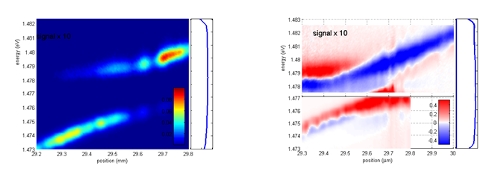Rechercher
Accueil > La Recherche > Axes & Equipes > Physique de l’Exciton, du Photon & du Spin > Optique des états collectifs et des spins (OECS) > Etats collectifs dans les semiconducteurs > Condensats de polaritons et lasers à polaritons dans les microcavités GaN, ZnO
Polariton spin dynamics
publié le
We were also interested in polaritons spin dynamics in II-VI microcavities with embedded diluted magnetic quantum wells, and III-V microcavities with embedded GaInAs quantum wells, in the framework of the european RTN network CLERMONT2 (2002-2007). This work has been done in collaboration with LPN and SP2M/CEA for microcavities growth, and with LASMEA and A. Kavokin for modelling.
It gave rise to the PhD thesis of Adalberto Brunetti in May 2007, and to an invited paper at the PLMCN7 Conference in Havana.
The most promising results are the following. First a tiny splitting of the polariton branches at k=0 into two linearly polarized modes has been evidenced. This comes from a symmetry breaking of the ideal microcavity, the origin of which is still not well understood. Second, in the non-linear regim a different transmission in linear and circular polarisations appears, which we call mixed dichoïsm. Such effect is forbiden in linear optics, but allowed in non-linear optics. We found that the mixed dichroïsm is mainly a consequence of spin-dependent polariton-polariton interactions, which opens up a new way to determining the corresponding interaction constants.









